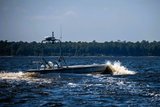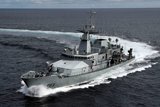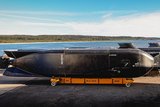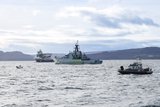Royal Australian Navy test-fires Raytheon Standard Missile-2
The Royal Australian Navy fired Raytheon Company's Standard Missile-2 Block IIIA anti-air warfare missile during recent tests on board the HMAS Melbourne.
"With this firing, Melbourne's crew validated the work done to transition warships from SM-1 capability to SM-2," said Ron Shields, Raytheon's SM-2 program director. "This was the first time an SM-2 has been launched by any navy from an upgraded frigate, clearing the way for other fleets to make similar upgrades."
As the most widely fielded variant of SM-2, Block IIIA is deployed by the US and eight allied navies. The missile is part of a long-range area air defense capability capitalizing on communication techniques, midcourse guidance, advanced signal processing and propulsion improvements. These enhancements substantially increase the intercept range to 90 nautical miles (104 statute miles) and provide high- and low-altitude intercept capability and performance against advanced anti-ship missile threats.
Three other Royal Australian Navy frigates are scheduled to be upgraded to the SM-2 configuration. The modifications, along with upgrades to the combat management systems, launchers and other systems, will improve the ships' capabilities against low-altitude and supersonic targets and provide extended area air defense protection.
"Standard Missile has been the US Navy's primary surface-to-air fleet air defense weapon for more than three decades," said Shields. "This test shows the flexibility of SM-2, and why it is the global air defense missile of choice."
Source: Raytheon
More from Naval Warfare
-
![Canadian Coast Guard’s OOSV delivery is “major milestone” in fleet modernisation]()
Canadian Coast Guard’s OOSV delivery is “major milestone” in fleet modernisation
The Polar Class 6 platform is the largest CCG science-dedicated vessel and will operate on the country’s east coast.
-
![How the Anduril-HHI autonomous ship plan fits in with the US Navy’s MASC programme]()
How the Anduril-HHI autonomous ship plan fits in with the US Navy’s MASC programme
The new modular vessel is expected to be developed for both commercial and defence use, with a heavy focus on production speed and mission flexibility.
-
![Indo Pacific 2025: Autonomous systems reigned but can the Australian Defence Force afford it?]()
Indo Pacific 2025: Autonomous systems reigned but can the Australian Defence Force afford it?
Multiple autonomous systems and technologies were on display at this year’s Indo Pacific, but questions remain over how the Australian Department of Defence will balance the books.
-
![How the UK Royal Navy is powering up its hybrid fleet to combat new threats]()
How the UK Royal Navy is powering up its hybrid fleet to combat new threats
Since it announced its move towards a new “hybrid navy” earlier this year, the force has announced a number of new uncrewed technologies in the works.
-
![US and UK to begin Trident II D5 Increment 8 in October 2026]()
US and UK to begin Trident II D5 Increment 8 in October 2026
Trident II D5 Increment 8 will involve improvements to the shipboard navigation subsystem for the US Ohio and Columbia and the UK Dreadnought and Vanguard submarine classes.






















